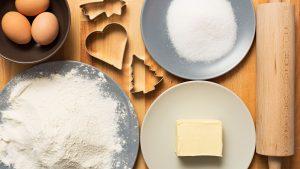Ever wondered why some cookies turn out soft and chewy while others end up hard and crumbly? It all boils down to how you handle those crucial wet ingredients.
Today, we’re diving into the art of cookie-making and answering the age-old question: Should you combine all your wet ingredients at once?
Join us as we uncover the secrets to crafting perfect cookies, one step at a time.
Mastering the Art of Cookie Dough: The Right Way to Mix Wet Ingredients.
When mixing wet ingredients for cookies, the order and method of combining them can affect the texture and consistency of your cookie dough.
To maintain specificity and context, let’s go through the steps of mixing wet ingredients for cookies:
Butter and Sugars: Start by creaming together your room temperature butter and sugars.
This typically involves combining softened butter with granulated sugar and brown sugar in a mixing bowl.
Creaming helps create air pockets that result in a softer and more tender cookie.
You can use an electric mixer or a wooden spoon for this step. Beat them together until the mixture becomes light and fluffy, which usually takes 2-3 minutes.
Eggs: Add your eggs one at a time to the butter-sugar mixture, ensuring each egg is fully incorporated before adding the next.
This step ensures even distribution of the eggs and helps the cookies hold together. Mixing too vigorously can sometimes lead to a tougher texture, so aim for a thorough but gentle incorporation.
Vanilla Extract: Once the eggs are well mixed in, add vanilla extract for flavor. Mix it in until it’s evenly distributed.
Other Wet Ingredients: If your recipe calls for other wet ingredients like milk or yogurt, add them at this point and mix until fully combined. These ingredients can add moisture and flavor to the cookies.
Dry Ingredients: In a separate bowl, whisk together your dry ingredients such as flour, baking soda, and salt.
Then gradually add the dry mixture to your wet mixture. Mix until just combined.
Overmixing can lead to tougher cookies, so stop as soon as there are no visible streaks of flour.
It’s common to finish mixing by hand at this stage to avoid overworking the dough.
Mix-Ins: Finally, if your cookie recipe includes ingredients like chocolate chips, nuts, or dried fruits, fold them into the dough using a spatula or a wooden spoon. Again, avoid overmixing at this point; just mix until they are evenly distributed.
The key to successful cookie making is not overmixing at any stage, as this can lead to tough cookies.
It’s also important to follow the specific instructions in your recipe, as some variations may exist depending on the type of cookie you’re making.
By following these steps and paying attention to the details, you can achieve the desired texture and flavor for your cookies.

Further explanations: exploring whether Mixing Wet Ingredients at once is right when for Cookies Dough.
let’s break down the process of mixing wet ingredients for cookies in more detail:
Creaming Butter and Sugars:
Start with room temperature butter. Softened butter is easier to work with and helps create a smooth mixture.
Place the softened butter in a mixing bowl.
Add both granulated sugar and brown sugar to the butter. Granulated sugar provides sweetness, while brown sugar adds moisture and a hint of caramel flavor.
You can use an electric mixer with the paddle attachment or a wooden spoon for this step.
Begin mixing the butter and sugars together at medium speed if using an electric mixer or by hand if using a wooden spoon.
Creaming is a process where you beat the butter and sugars together until they become light and fluffy. This takes about 2-3 minutes with an electric mixer and longer by hand.
During this process, the sugar granules help create tiny air pockets in the butter, which will contribute to a softer and more tender cookie texture.
Adding Eggs:
Crack your eggs into a separate bowl to ensure they are fresh and to avoid any unwanted shell fragments.
Add the eggs to the creamed butter and sugar mixture one at a time.
After adding each egg, mix it into the batter thoroughly before adding the next one. This ensures that each egg is fully incorporated.
Mixing the eggs in one at a time helps evenly distribute the liquid and fat in the eggs throughout the dough. This contributes to the cohesiveness of the cookie dough, helping it hold together when baked.
It’s important not to overmix at this stage. Mix just enough to incorporate the eggs.
Incorporating Vanilla Extract:
Once the eggs are well mixed into the dough, it’s time to add flavor. Vanilla extract is a common choice.
Pour the desired amount of vanilla extract into the dough.
Mix the vanilla extract into the dough until it’s evenly distributed.
Vanilla extract adds a pleasant aroma and flavor to the cookies.
By following these steps meticulously, you ensure that your wet ingredients are properly mixed for cookie dough.
This process creates a base that, when combined with the dry ingredients and any mix-ins, will yield delicious, tender, and flavorful cookies.
Remember to follow your specific recipe for exact measurements and instructions to achieve the best results.
let’s dive deeper into the remaining steps of mixing wet ingredients for cookies, as well as incorporating dry ingredients and mix-ins:
Other Wet Ingredients:
If your cookie recipe calls for additional wet ingredients like milk or yogurt, it’s important to add them at this stage. These ingredients can enhance the moisture and flavor of your cookies.
Pour the specified amount of milk, yogurt, or any other wet ingredient into the cookie dough.
Mix these ingredients into the dough until they are fully combined. This ensures even distribution of the added moisture and flavor throughout the dough.
For milk, you might add it gradually, stopping when you achieve the desired cookie dough consistency specified in your recipe.
Dry Ingredients:
In a separate bowl, combine your dry ingredients. Common dry ingredients for cookies include all-purpose flour, baking soda, and salt. You may also have additional dry ingredients like cocoa powder, spices, or oats, depending on your recipe.
Whisk or sift the dry ingredients together. This helps evenly distribute leavening agents like baking soda and ensures that there are no clumps of flour or other dry ingredients.
Gradually add the dry mixture to your wet mixture. You can do this in stages, adding a portion of the dry mixture, mixing until just combined, and then repeating until all the dry ingredients are incorporated.
It’s crucial not to overmix at this stage. Overmixing can lead to the development of too much gluten, resulting in tough cookies.
Stop mixing as soon as there are no visible streaks of flour or dry ingredients. Some recipes might even recommend finishing mixing by hand to ensure gentle incorporation.
Mix-Ins:
Mix-ins are ingredients like chocolate chips, nuts, dried fruits, or candies that add texture and flavor to your cookies.
After you’ve combined the wet and dry ingredients, it’s time to add these mix-ins.
Gently fold the mix-ins into the dough using a spatula or a wooden spoon. Folding means to carefully combine them without vigorous stirring. This prevents overmixing and ensures that the mix-ins are evenly distributed throughout the dough.
The goal is to distribute the mix-ins without breaking or crushing them. Be thorough but gentle to maintain their integrity.
By following these steps, you create a well-mixed cookie dough with the right balance of wet and dry ingredients.
Proper mixing techniques ensure that your cookies turn out with the desired texture, flavor, and appearance.
Always refer to your specific cookie recipe for exact measurements and instructions, as the order and quantities of ingredients can vary from one recipe to another.
A complete tabular on this topic here.
Here’s a complete tabular breakdown of the process of mixing wet ingredients for cookies:
| Step | Description |
|---|---|
| 1. Creaming Butter and Sugars | – Combine softened butter with granulated sugar and brown sugar in a mixing bowl. – Cream together until light and fluffy (2-3 minutes). – Use an electric mixer or wooden spoon. |
| 2. Adding Eggs | – Add eggs one at a time to the creamed butter-sugar mixture. – Fully incorporate each egg before adding the next. – Avoid overmixing. |
| 3. Incorporating Vanilla Extract | – Add vanilla extract for flavor. – Mix until evenly distributed in the dough. |
| 4. Other Wet Ingredients | – If the recipe calls for additional wet ingredients like milk or yogurt, add them now. – Mix until fully combined. |
| 5. Dry Ingredients | – In a separate bowl, whisk together dry ingredients (e.g., flour, baking soda, salt). – Gradually add the dry mixture to the wet mixture. – Mix until just combined, avoiding overmixing. |
| 6. Mix-Ins | – Fold in mix-ins (e.g., chocolate chips, nuts, dried fruits) using a spatula or wooden spoon. – Mix until evenly distributed, without overmixing. |
This tabular breakdown provides a clear and organized overview of the steps involved in mixing wet ingredients for cookie dough, ensuring that you follow each step accurately to achieve the desired cookie texture and flavor.
My final words: When Mixing Wet Ingredients for Cookies: Should You Combine Them All at Once?
In conclusion, when mixing wet ingredients for cookies, it’s essential to follow a specific order and technique for optimal results.
Start by creaming butter and sugars to create a light and fluffy base.
Then, add eggs one at a time and incorporate them thoroughly. Introduce flavorings like vanilla extract and any additional wet ingredients before gently mixing in the dry ingredients.
Finally, fold in mix-ins, being careful not to overmix at any stage. This systematic approach ensures that your cookie dough is well-balanced and leads to delicious, tender cookies.

Whether you’re a passionate baker or simply seeking sweet inspiration, I’m here to provide you with valuable insights, mouthwatering recipes, expert tips, and more to make your cookie adventures with Mike truly delightful and scrumptious. You are on the true exciting cookie-filled side.





